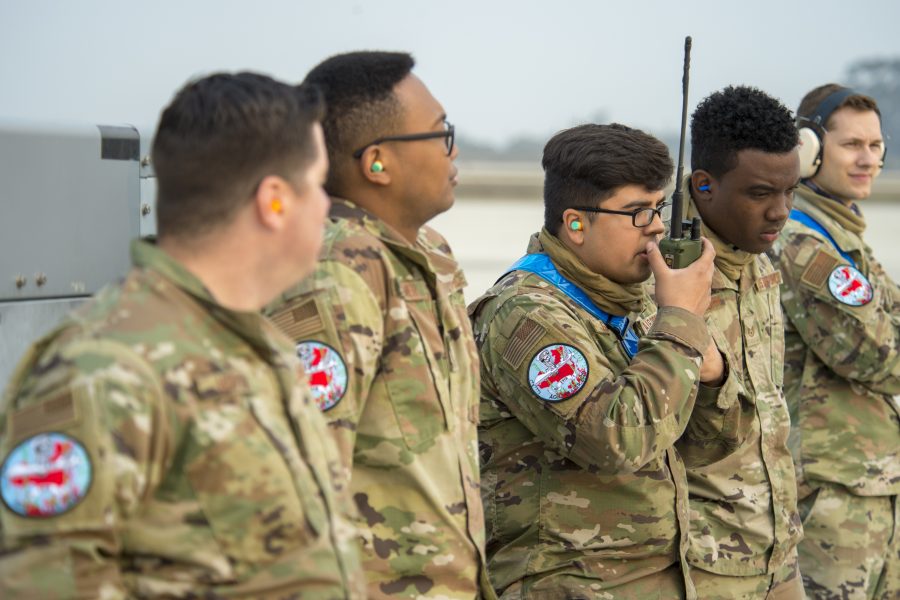MQ-9 Reapers, the workhorse drone of America’s two-decade counterterrorism fight in the Middle East and Africa, want to show they’re getting a second wind.
The MQ-9 workforce is fighting to keep its place in the Air Force as the service looks to end production of the aircraft and begins scoping out its replacement. The Air Force has grown skeptical that the Reaper could hold its own against advanced nations like Russia and China, which could shoot the non-stealthy aircraft down or jam its transmissions. Military officials worry the Reaper is too vulnerable and lacks the stealth, electronic protections, and speed that planes will need to survive.
In the absence of upgrades that would protect the drone in challenging airspace, the MQ-9 enterprise is adapting its tactics and training to prove useful in a theater of war that looks much different from its typical surroundings.
The MQ-9 schoolhouse at Holloman Air Force Base, N.M., recently rewrote its syllabus to prepare Reaper pilots and sensor operators for a more complex fight, 29th Attack Squadron Commander Lt. Col. Brian Davis told Air Force Magazine in a Sept. 21 interview.
“It incorporates maritime interdiction capabilities, it incorporates a lot more major contingency operation capabilities, air interdiction,” Davis said. “It reinvigorates our strike coordination and reconnaissance capability, and it also increases our combat search and rescue capability.”
The Air Force approved the new coursework shortly before the start of Exercise Agile Reaper, the first training event focused on those tactics in the Pacific. In keeping with the pivot away from the Middle East, patches on Airmen’s uniforms made for the event feature an MQ-9 superimposed over a red silhouette of China.
The exercise at Naval Air Station Point Mugu, Calif., began Sept. 3 and will end Sept. 29. It partners three MQ-9s with the Navy’s Third Fleet, which deploys carrier strike groups, submarines, and other sea vessels and aircraft to the Eastern Pacific, along with Air Force C-130s, and special warfare and Marine Corps personnel, Davis said.
“It’s a demonstration of our capability to rapidly move the MQ-9 anywhere in the world, to unfamiliar locations, and then get out and show the operational reach capabilities of the MQ-9 to provide maritime domain awareness to our joint service partners,” Davis said.
Though Davis declined to provide specifics about the exercise because of operational security concerns, he said MQ-9s were contributing information to a common operating picture that helped the Navy decide where to strike. Reaper operators handled maritime strike coordination and reconnaissance, counter-fast attack craft operations, and close air support over water.
For strike coordination and reconnaissance missions, Reapers would pick up on activity in the area and ensure other aircraft are clear to fly in and fire at their targets. MQ-9 unit commanders have discussed bolstering that and similar missions for at least three years as anti-aircraft threats grow around the world and the Pentagon’s priorities began to change.
In 2017, the head of the 432nd Air Wing at Creech Air Force Base, Nev., said training crews to handle that work would take about a month because they spend most of their time on airstrikes and collecting surveillance imagery. Now, Davis indicated those flights are part of a growing maritime portfolio for the MQ-9.
“We can look out at very long ranges that a lot of our other aircraft in the U.S. Air Force inventory cannot get out to, and we can possibly ID vessels … without the use of tankers or other logistical requirements,” Davis added. The aircraft flew about 2,000 miles to reach the exercise, showing how far it can travel without stopping or accounting for the needs of a human pilot in a cockpit.
As the Reapers handled airstrikes during a mock amphibious assault on San Clemente Island off the California coast, they also looked more than 100 miles away to see where the Navy should strike vessels at sea.
He added that MQ-9s are connecting to military space assets in new ways for command and control, targeting, and navigation, but did not elaborate. A photo taken at the exercise showed an Airman setting up a satellite communications antenna at Point Mugu.
Agile Reaper posed the opportunity to try out a deployable control system that lets Airmen fly the MQ-9 outside of a typical storage container or brick-and-mortar building. Davis declined to discuss how those controls performed, but said it proves Reaper operations don’t need a large, well-established logistics footprint to handle missions.
Units across the Air Force are practicing quickly packing up and deploying to and from austere locations that lack the infrastructure of a regular air base, in case installations are threatened or hit in a future war.
“We surprised the entire community by how rapidly we can set up and operate the MQ-9 at its full capability. That portion went really well,” Davis said. “The things that didn’t go so well are just a nature of rinsing and repeating, because this is the first time we’ve ever done it.”
The exercise will spur further changes to the MQ-9 training program to incorporate what Airmen learned, he added.

